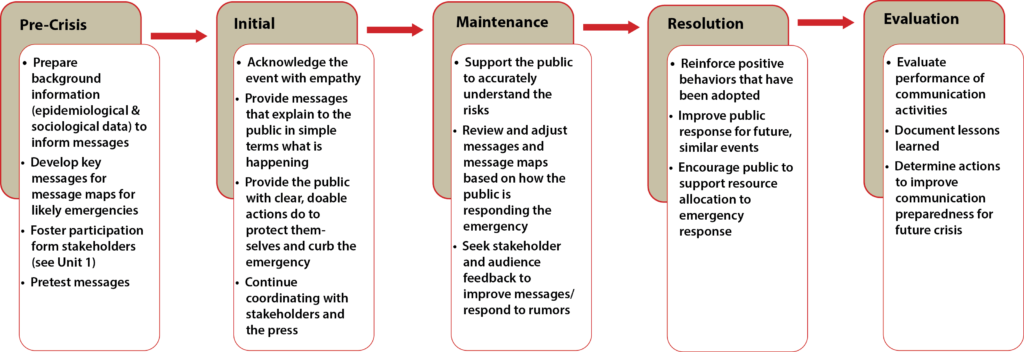This unit describes the steps involved in message development. It notes how initial messages that need to be rapidly disseminated at the onset of an emergency should evolve and be incorporated into the broader SBCC strategy to address specific communication objectives for intended audiences.
This unit brings together key elements from all previous units to ensure that messages are evidence-based and respond to relevant needs in contextually appropriate ways. The unit provides a range of tools, tips and recommendations for effective message design, and particular emphasis has been placed on pretesting.
Having completed this unit, you will have the following tools to assist in putting together your SBCC strategy for the emergency response:
What Is Message Development?
Message development involves putting together the information that needs to be conveyed to the general public and to the intended audiences during an emergency. Messages are likely to change as the emergency evolves, with different phases of the emergency requiring a different focus. Messages can have a variety of purposes depending on the communication objective and on the audiences being targeted:
- Educate about how to assess and manage risk
- Inform about risk-reduction behaviors
- Promote risk-reduction behaviors and practices
- Increase trust between the public and authorities or service providers
- Reduce and dispel rumors
- Reduce fear and stigma
- Nurture advocacy
- Promote social cohesion
- Resolve conflicts and controversies
Well-designed messages are specific to the audiences and should clearly describe both the desired behavior and the benefits that can be reaped by engaging in it.
Why Is Message Development Important?
Messages are key in providing consistency to the communication response. This is particularly important during an emergency, when fear and anxiety can breed rumors and affect the ways in which people respond. Developing key messages allows multiple partners to speak with one voice, in a clear and concise way. As the same, consistent messages are disseminated across all channels of communication in a harmonized manner, they reinforce each other and increase the effectiveness of SBCC efforts.
Time constraints during an emergency may lead programmers and planners to develop quick, generic messages based on technical information and scientific evidence only. However, technical messages alone, even if formulated in simple, understandable language, are unlikely to be fully effective in promoting desired behaviors. Messages need to take into account the local context, traditions, culture and potential stigma associated with the emergency.
Messages, their content, the way they are formulated and the audiences they target, are likely to evolve as the emergency progresses. In the initial phase of an emergency, the focus needs to be on disseminating information to the general public quickly and empathetically about simple, doable protective actions. In the subsequent phases, messages will likely need to be refined to reflect local perceptions associated with the emergency and the perceived consequences of performing the desired behaviors. As information about at-risk groups and behaviors that aggravate the emergency become better known, messaging would also become more tailored to address specific behaviors and target specific audiences.
The graphic below illustrates how messages should evolve during the phases of an emergency.

Taking into consideration that messages need to be reviewed, refined, added and even change throughout an emergency based on how it evolves, there are a series of steps that can be done before and during the crisis to support the development of effective SBCC messages.

